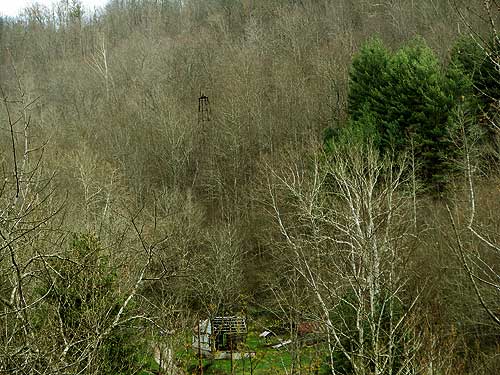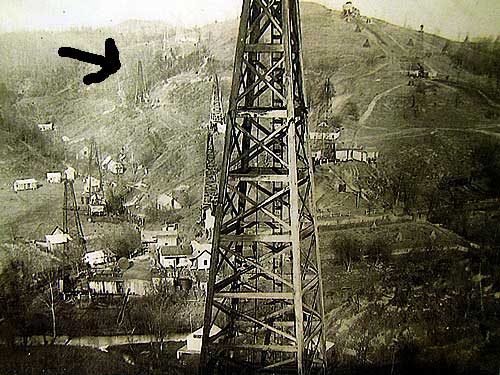
When the leaves are off the trees, you can see this old oil derrick on the hill across the river from our farm. It’s on Frank’s place. He has a hunting cabin up the hill (his house is at the bottom), and this old derrick is just above it. These old derricks were supposed to be taken down, for safety reasons, but a few still exist, scattered in forgotten rural hills. (You can see our derrick, which is on our hill near our house, here.)
The derrick pictured above (in a photo I took last year when the leaves were off) is one of the derricks in this photo:

I think it’s the one I pointed the arrow to, but we can never decide for sure if it’s that one or the one just to the right of it. Trees blur the ridgeline these days and make it difficult to pinpoint a spot on photos of cleared hills. It’s always amazing to me to imagine the activity of the tiny bustling community, complete with school, church, several stores, boardinghouse, gasoline plant, and more that once existed here, and I feel envious of those who saw it then and grateful at least for their stories.


Ramona says:
That’s a lot of them in one small area. Cool pictures!
On October 11, 2010 at 8:43 am
Phyllis R says:
Get all the history you can from your relatives. Too much is lost because elders don’t think it is important, and children seem to feel the same. Knowing where your family came from, who they were and how they lived is one of the best things you can inherit.
On October 11, 2010 at 9:09 am
BuckeyeGirl says:
That last paragraph in your father’s story moved me to tears, even though I’ve read it before. I hope there’s other people who know where the Indian Princess Bath is, and how to find the overgrown foundations and which one is which. It’s all pretty darn special, more special than words can say.
On October 11, 2010 at 9:12 am
Leanna says:
A bit sad and eerie to think a whole town is gone. Thanks for the reminder that there are stories everywhere!
On October 11, 2010 at 10:30 am
Nancy in Iowa says:
Your stories fascinate me, almost as much as I’m sure they do you. You are firmly tied to that area, and I hope the kids appreciate it as well. I’ve seen a few very old pictures of the area in PA that was my first home. Keep on sharing with us!!!
On October 11, 2010 at 10:47 am
Cousin Sheryl says:
Here is a fact that WV History buffs know:
Before WW II, West Virginia had a population of 3 million people. During the war, many people left to work in war plants in Akron, Cleveland, Richmond, Norfolk and Oak Ridge. Then, they stayed there. Also, soldiers returning from the war also moved out of state. The population dropped to 1.75 million. It has never significantly recovered. WV’s population is currently 1.8 million. The entire WV population spread out in these mountains is the same population size as the current City of Cleveland, Ohio.
The oil boom is over and mechanization has caused a severe drop in coal mining jobs. Also, much of our chemical industry has been moved overseas.
This is why whole towns such as Stringtown are now abandoned. Drive through any rural WV community and you will see abandoned farms and barns. It is kind of sad.
But, fortunately, some people like Suzanne hear the mountain’s call and return.
American by birth, West Virginian by the grace of God!
:happyflower:
On October 11, 2010 at 12:51 pm
KentuckyFarmGirl says:
I have recently started researching the genealogy of both my parents and it’s fascinating! Thank you for sharing a bit of yours with us. I’, heading over to read the Stringtown story now.
On October 11, 2010 at 1:11 pm
Lisa Carper Stott says:
As I carefully inspect your old photograph, I wonder where in the picture my grandmother was born. She was born in Stringtown somewhere in 1917.
On October 11, 2010 at 3:23 pm